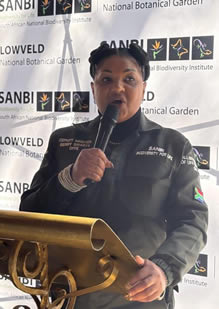Deputy Minister: B Swarts: keynote address during relaunch of pedestrian bridge and opening of new viewing deck at Lowveld National Botanical Garden In Mbombela (Nelspruit), Mpumalanga
04 July 2025
Professor Edward Nesamvuni, Chairperson of the Board for the South African National Biodiversity Institute (SANBI),
Chief Executive Officer of SANBI, Mr Shonisani Munzhedzi,
Deputy Director General of the Department of Forestry, Fisheries and the Environment,
MMC City of Mbombela, Cllr. Morris Mazibano
MMC Ehlanzeni District Municipality, Cllr. Phazama Abraham
Members of the board, members of the media, ladies and gentlemen.
It is my pleasure to open the new viewing deck and relaunch the pedestrian bridge here at Lowveld National Botanical Garden today.
The DFFE supports the mandate of the South African National Biodiversity Institute (SANBI), as the organisation contributes to South Africa's sustainable development by facilitating access to biodiversity data, generating information and knowledge, building capacity, providing policy advice, showcasing and conserving biodiversity in its national botanical and zoological gardens.
A safe, healthy and sustainably managed environmental and natural resource base provides critical ecosystem services that are a foundation for economic and social development. The Department of Forestry, Fisheries and the Environment has funded a number of projects at SANBI through the Greening and Open Space Management (GOSM) programme over the past couple of years. In the Lowveld National Botanical Garden (NBG), this has included the refurbishment of the Garden's nurseries supporting local SMMEs, as well as labour-intensive trails and pathway maintenance, repairs and painting of fences as well as the removal of alien and invasive plants from the garden. In other gardens the GOSM support has extended to new wetland boardwalks, paving of pathways, new visitors' centres, irrigation upgrades, an outdoor gym, children's edutainment garden, and new growing tunnels for plant propagation.
Gardens of the Future
SANBI's gardens division manages SANBI's network of National Botanical and Zoological Gardens, each with their associated tourism infrastructure and conservation estates, and Interpretation Section. 'Conservation Gardens' is the international term for botanical gardens that include both landscaped and natural areas within their boundaries.
The gardens of the future contribute to the socio-economic objectives of government through conservation, tourism, education, research and recreation.
Lowveld National Botanical Garden – KISS Strategy
The Lowveld National Botanical Garden is one of SANBI's flagship gardens and is also one of South Africa's eleven national botanical gardens. The 165-hectare garden is surrounded by urban development and is, thus, a treasured urban oasis and pristine getaway for thousands of people residing in Mbombela.
The garden sits in Nelspruit, Mbombela near the Skukuza Gate to Kruger National Park. It is also in close proximity to the Panorama Route which is a scenic drive in Mpumalanga, South Africa, known for its breathtaking views of the Drakensberg Escarpment and the Lowveld. The Lowveld National Botanical Garden was established in 1969.
The character of the garden is shaped by the two main rivers that cut across it, namely the Crocodile and Nels rivers. Before these two rivers converge in the Garden, they form spectacular waterfalls which can be viewed at the Cascades and the Nels viewpoints.
The Crocodile River, that starts in the Mpumalanga highveld, passes through the garden down to Mozambique. When the Crocodile River is low, interesting geological formations are visible. The garden plays a critical role in conservation of rare and endangered species and played a pivotal role in establishing the cycad gene bank. The garden also boasts one of the largest collections of South African fig trees.
The mystical baobab tree is famous for its unique shape and medicinal properties. Various plant species have been introduced into the garden. These include South African coastal species and a unique collection of plants which represent the rapidly disappearing tropical forests of central and west Africa.
The pedestrian bridge and viewing deck
In 2004 a pedestrian bridge was built using the Expanded Public Works Programme (EPWP) funding, providing new access for visitors across the Crocodile River, from the eastern side of the garden to the western side (Riverside). On 12 February 2023 abnormally heavy rains in the eastern parts of South Africa resulted in damage to the pedestrian bridge and parts of the bridge being washed away, as a result of a slow-moving upper-air cut-off low pressure system that lingered over the South African interior.
Today, we are pleased to announce that the bridge has been restored.
A new viewing deck (6m x 6m) using galvanised structural steel and composite material platform was also constructed. The restored raised pedestrian bridge and new viewing platform are now both fully functional and accessible to the public.
This garden is a garden for the people. So today, I am inviting you as members of the community who live and work in Nelspruit to use this garden as your own. For your health and wellbeing as well as the education for your children.
The education programmes in the garden are designed to educate and engage children with nature through curriculum-linked lessons in various botanical gardens. The programme reaches learners from grades R to 12, offering lessons on diverse environmental themes. These lessons are designed to be fun, hands-on, and interactive, encouraging children to explore and learn about biodiversity, ecology, and sustainability.
Partnership possibilities
Ladies and gentlemen, I call on the private sector to partner with SANBI in the development and upgrade of infrastructure in our botanical gardens. Such collaborations not only supports the socio-economic goals of the country, but it also contributes to the environmental, social and governance frameworks for organisations in our sector. I also urge academic institutions and civil society to continue to collaborate with SANBI to ensure that South Africa's biodiversity is conserved for the benefit of all.
I thank you.


